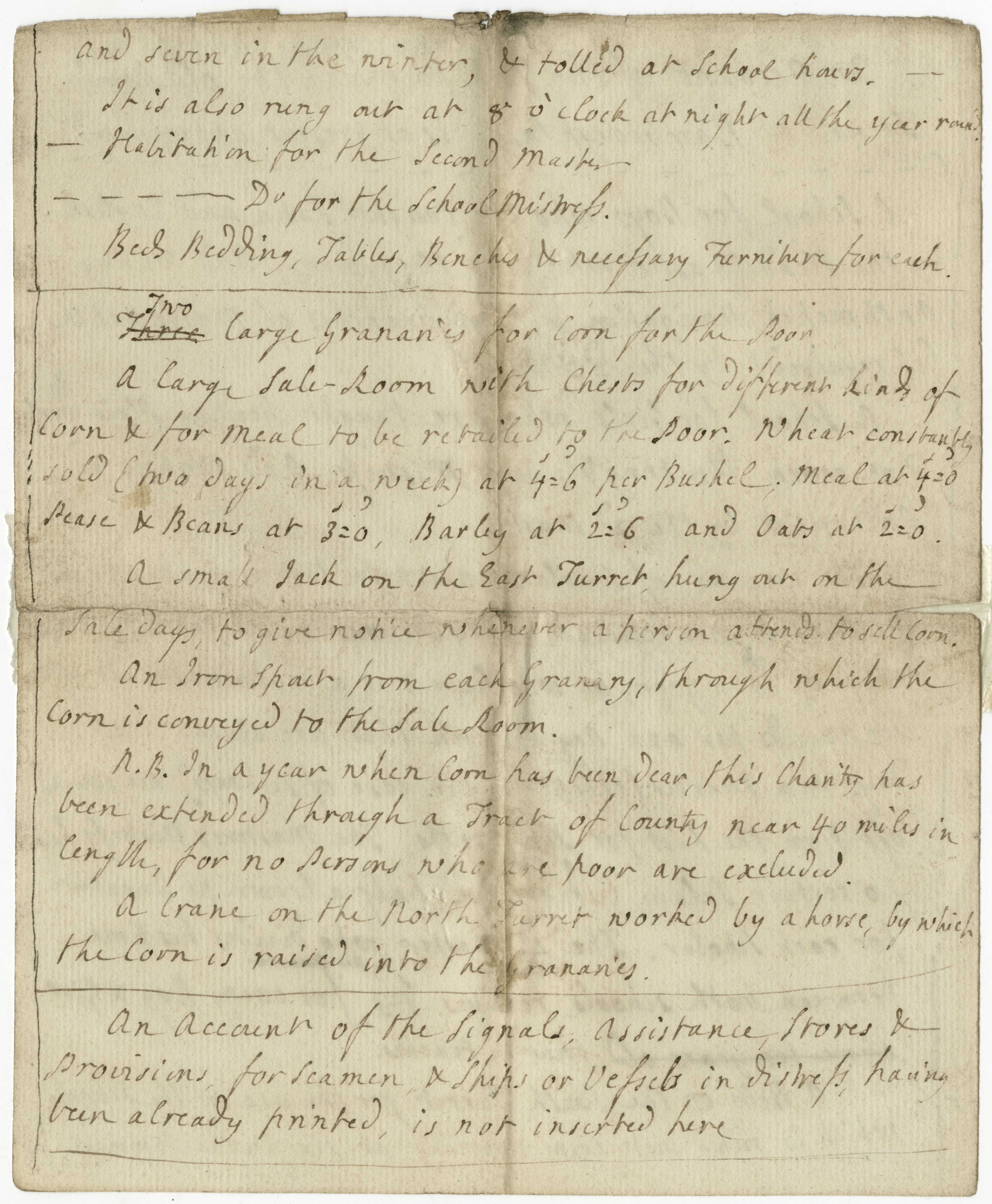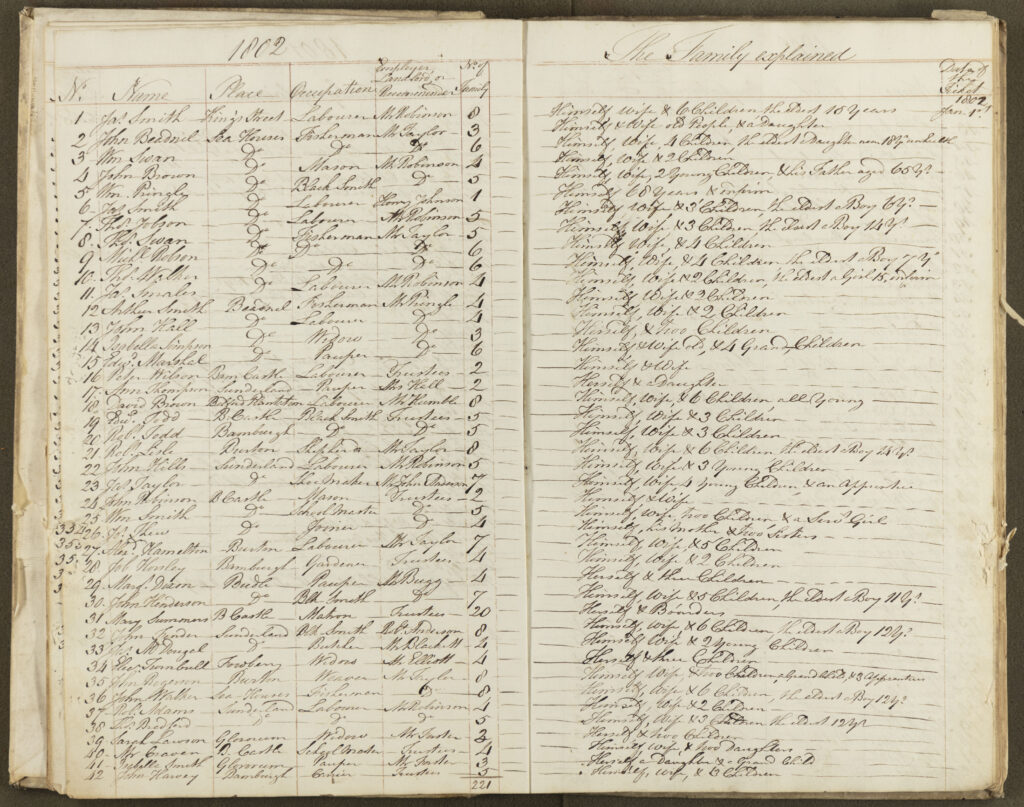CORN CHARITY, GRANARY & CHEAP SHOP
CONTEXT
The corn charity for the provision of subsidised food began in 1766, making it one of the earliest in Dr John Sharp’s Bamburgh charity endeavours. Corn, and in later years peas, beans, oats, and barley, were bought from tenant farmers on trust land under the terms of their lease.
The goods were sold at a low, fixed price. As shown in ‘An account of the uses to which the old Roman Tower in Bamburgh Castle is at present appropriated’, c.1780 (NRO 00452/D/8/4/8/4b), items were sold at the following costs:
- Wheat – 4s 6d per bushel (about £24 in 2023).
- Peas and beans – 3s 1d (about £16.50 in 2023).
- Meal – 4s (about £21.50 in 2023).
- Barley – 2s 6d (about £13.50 in 2023).
- Oats – 2s (about £11 in 2023).
Similarly to how the schools operated, the use of the corn charity was restricted to those at a certain poverty level. Those wishing to buy from the corn charity had to prove their level of poverty and provide a note of recommendation from a trustee, a local clergyman, or a landowner. The prospective customers were then given a ticket of entitlement.
After a local man complained of the system being abused, with no account being taken of the family size of the purchaser, and some selling on excess corn for profit, registers were made to record the details of customers. This included their name, place of residence, occupation, family size, and circumstances.
Sale days were held twice weekly in a sale room within the keep of Bamburgh Castle, with corn and meal being held for purchase within chests.
Corn was moved to the sale room by a crane from the north turret powered by a horse, which hoisted the supplies to the granaries which had been constructed on the upper floors of the keep. Goods were conveyed from the granaries to the sale room by an iron spout.
A malt mill, barley mill, and hand querns were available at the castle for the use of purchasers.
During times of crop shortages or when the price of corn was particularly high, the demand at the corn charity increased substantially and they were inundated with customers. A particularly bad winter during 1782/83 led to crop shortages, starvation, and even riots. George Hall, the castle foreman and manager of the corn charity recorded serving 120 people on 7th December 1782 (NRO 00452/C/3/2/12/57), and that several more went away emptyhanded when supplies ran out. It was later recorded in February 1783 (NRO 00452/C/3/2/13/13) that some people were queuing from as early as 2am on the assumption of first come first served. Some had travelled as far as 40 miles. Dr Sharp placed no limit on the distance perspective purchasers could travel.
After Dr Sharp’s death in 1792, the supervision of the corn charity and granary passed to the castle agent. The castle agent added the Christmas distribution of beef and tallow to the accounts.
In 1796, the cheap shop was established as a subsidiary of the corn charity. Miscellaneous grocers’ goods such as candles, blue pepper, starch, barley, rice, ginger, alum, pins and butter were sold at cost price.
A windmill was constructed in 1800 to grind corn to be sold at the cheap shop. This still stands at Bamburgh Castle today.
DOCUMENTS
In this letter of 14 December 1776 George Hall describes the ongoing work at Bamburgh Castle. Reference is made to work on the granary – the floor has been filled with rubbish and nailed down. The plasterwork is ongoing. Hall refers to a sailor staying at the Castle. The sailor is lame but does not have any broken bones. The Charity provided refuge, board and medical support to shipwrecked sailors at Bamburgh Castle. Reference is made to “a vast many children under inoculation in our nighbourhood (sic)”. Smallpox inoculation of the poor without charge was another innovation introduced by the Charity.
George Wood was accountant to the Lord Crewe Trustees. In this annual account sheet he sets out payments made to local farmers for the provision of a range of grain – barley, corn, oats, meal, pease and wheat to the charity’s granaries. Dr. John Sharp established four granaries- two in Bamburgh Castle and two in Bamburgh village. The granaries were open two days per week and were sold produce to any poor person who lived within a forty-mile radius of Bamburgh. The document provides information about the farmers that provided grain to the granaries – in most cases the name or situation of the farm is recorded and the quantities of grain provided with costs. The sums involved are large. One of the totals recorded is £702, equivalent to about £55k today. A boll was a measurement of quantity, the extent of which varied from area to area. It generally equated to about six bushels – a bushel equated to about 36.4 litres meaning that a boll was approximately 218.4 litres. The quantities listed give an impression of the demand placed upon the granaries.
The Corn Charity was established in 1766 to provide the poor of the area with subsidised grain. In the 18th century corn was a generic term used to describe grain – probably barley, oats and wheat. This page dated 1797 lists the local farmers that the charity purchased grain from. Most of the farms formed part of the Lord Crewe estate – the Charity leased the farms to the farmers and bought some of their produce back from them. This arrangement may have been set out in the leases issued to tenants. Reference is made to oats and pease sold to the stables at Bamburgh Castle. The usual diet for a horse at this time would be chaff (chopped hay and straw), mixed oats and beans or peas. The total value at the bottom of the page £907 16s 9d roughly equates to about £70k at today’s values.
This page, dated 23 August 1804, forms part of a volume of accounts listing the goods in hand in the Bamburgh Castle Cheap Shop together with their values. The products listed are mostly recognisable to us. Allum (Alum), rosin and saltpetre were all used in home remedies. The document suggests that relatively large quantities of stock were bought in and maintained. The total value at the bottom of the page £292 14s 5d roughly equates to about £15k at today’s values.
Grains produced in the Bamburgh granaries were sold in the Meal Shop. This document is a sample pages from the monthly account book of the shop, 1799-1840. The page details quantities of grain, barley, oats, oatmeal and seeds sold through the shop. It also references the sale of dust – a by-product of the milling process and probably sold to make cheap bread or possibly a form of porridge or gruel. Quantities of grain passing through the shop are large. The entry of 30 April 1818 records the sale of 232 stones and 7 pounds of oatmeal – approximately 1477 kilograms – and indicate the level of usage of the shop. There are several references to a loss made by the shop. It is likely that the aim was for the shop to break even, charging only the cost of buying the grain in.
Grains produced in the Bamburgh granaries were sold in the Meal Shop. This document is another page from the monthly account book of the shop, 1799-1840. This page lists quantities of beef and tallow distributed to the poor at Christmas 1816. Tallow is beef or mutton (sheep) fat and was used to produce candles to light homes. Pig fat was not used as it was very smoky and produced a pungent smell. Families that could afford to eat meat regularly might produce their own tallow. Families that ate meat irregularly needed to buy in supplies of tallow. The page does not include reference to payment which would suggest that users of the Meal Shop were given free beef and tallow at Christmas. The name of the recipient and their place of residence is given. In some cases, an indication of the household size is given. Entry number 3 references “Jane Hendry, her son & sister”. This may be an indication that Jane Hendry is a widow.
This sample page from the register of charity recipients at the Bamburgh Castle meal (or corn) shop lists those receiving support in 1802. The register lists the name of the head of the household, residence, occupation, the name of the employer, landlord or recommender, number of persons in the family, a description of the family and the date the ticket was issued. In order to use the shop a person had to present a ticket thereby demonstrating their need. A range of occupations are referenced – four paupers (presumably in receipt of poor relief), three blacksmiths, one butcher, one carrier, seven fishermen, one gardener, eleven labourers, two masons, one schoolmaster, one shepherd, one shoemaker, one weaver and three widows. One of the households – that of William Smith, a schoolmaster included a servant. The household of James Taylor, shoemaker, included an apprentice. Also included on the list is Mary Summers, matron of Bamburgh Castle School who wishes to use the Shop for herself and nineteen boarders at the School.
This is a sample page from a volume of Bamburgh Castle Cheap Shop invoices, 1855-1858. The page lists items purchased from Messrs. Lloyds & Co. The products listed are largely recognisable to us. Fig blue and powder blue were products used in laundry. We know that the Charity imported rice from Carolina to sell in the Cheap Shop. This sample pages begins to give us an idea of the products sold in the Cheap Shop, the quantities purchased, costs and the regularity of purchase in the mid 19th century.
FURTHER READING
The Charities of Nathaniel, Lord Crewe and Dr John Sharp 1721-1976 by CJ Stranks published by the Dean and Chapter of Durham 1976.
Memoirs of Nathaniel, Lord Crewe edited by Rev. Andrew Clark printed for the Camden Society 1893.
The Good Sharps by Hester Grant, Penguin Random House 2020
Dilston Hall…A Visit ot Bamburgh Castle with an account of Lord Crewe’s charties etc by WS Gibson published by Longman, Brown, Green and Longmans 1850
Dorothy and the Forsters of Bamburgh by John Bird, published by John Bird 1982
Bamburgh Belford Warenmouth Spindleston Outchester by Frank Graham published by Frank Graham 1976
Lord Crewe’s Charity website: https://www.lordcrewescharity.org.uk/
Northumberland Archives exhibition on Lord Crewe’s Charity: https://northumberlandarchives.com/exhibitions/crewe/1.html
Bamburgh Research Project website: https://bamburghresearchproject.wordpress.com/
Northumberland Archives blog on the electrifying machine: https://northumberlandarchives.com/2020/05/05/the-electrifying-machine-bamburgh-castle/
BBC Free Thinking feature on Bamburgh Castle surgery: https://dralun.wordpress.com/2015/11/02/bbc-free-thinking-feature-bamburgh-castle-surgery-c-1770-1800/
Article on overcrowded and underfunded 18th century hospitals: https://dralun.wordpress.com/2014/10/06/overcrowded-and-underfunded-18th-century-hospitals-and-the-nhs-crisis/
Article on 18th century medical jobs at Bamburgh Castle: https://dralun.wordpress.com/2014/01/22/do-you-need-a-doctor-applying-for-medical-jobs-in-the-eighteenth-century/
Article on 18th century medical job wages at Bamburgh Castle: https://dralun.wordpress.com/2014/01/24/negotiating-a-pay-rise-18th-century-style/
History Today article on Bamburgh Castle infirmary and dispensary: https://www.historytoday.com/hidden-hospital-bamburgh-castle-infirmary-and-dispensary
Article on Dr John Sharp: https://www.philanthropynortheast.com/the-philanthropists/sharp-dr-john
Bamburgh Bones website: https://bamburghbones.org/











